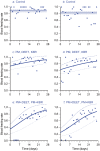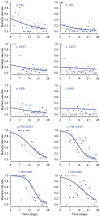Synergy between repellents and organophosphates on bed nets: efficacy and behavioural response of natural free-flying An. gambiae mosquitoes
- PMID: 19936249
- PMCID: PMC2775911
- DOI: 10.1371/journal.pone.0007896
Synergy between repellents and organophosphates on bed nets: efficacy and behavioural response of natural free-flying An. gambiae mosquitoes
Abstract
Background: Chemicals are used on bed nets in order to prevent infected bites and to kill aggressive malaria vectors. Because pyrethroid resistance has become widespread in the main malaria vectors, research for alternative active ingredients becomes urgent. Mixing a repellent and a non-pyrethroid insecticide seemed to be a promising tool as mixtures in the laboratory showed the same features as pyrethroids.
Methodology/principal findings: We present here the results of two trials run against free-flying Anopheles gambiae populations comparing the effects of two insect repellents (either DEET or KBR 3023, also known as icaridin) and an organophosphate insecticide at low-doses (pirimiphos-methyl, PM) used alone and in combination on bed nets. We showed that mixtures of PM and the repellents induced higher exophily, blood feeding inhibition and mortality among wild susceptible and resistant malaria vectors than compounds used alone. Nevertheless the synergistic interactions are only involved in the high mortality induced by the two mixtures.
Conclusion: These field trials argue in favour of the strategy of mixing repellent and organophosphate on bed nets to better control resistant malaria vectors.
Conflict of interest statement
Figures




Similar articles
-
Synergy between repellents and non-pyrethroid insecticides strongly extends the efficacy of treated nets against Anopheles gambiae.Malar J. 2007 Mar 29;6:38. doi: 10.1186/1475-2875-6-38. Malar J. 2007. PMID: 17394646 Free PMC article.
-
Mixture for controlling insecticide-resistant malaria vectors.Emerg Infect Dis. 2008 Nov;14(11):1707-14. doi: 10.3201/eid1411.071575. Emerg Infect Dis. 2008. PMID: 18976553 Free PMC article.
-
DEET microencapsulation: a slow-release formulation enhancing the residual efficacy of bed nets against malaria vectors.Trans R Soc Trop Med Hyg. 2008 Mar;102(3):259-62. doi: 10.1016/j.trstmh.2007.10.012. Epub 2007 Dec 20. Trans R Soc Trop Med Hyg. 2008. PMID: 18082862
-
Piperonyl butoxide (PBO) combined with pyrethroids in insecticide-treated nets to prevent malaria in Africa.Cochrane Database Syst Rev. 2021 May 24;5(5):CD012776. doi: 10.1002/14651858.CD012776.pub3. Cochrane Database Syst Rev. 2021. PMID: 34027998 Free PMC article.
-
Can anything be done to maintain the effectiveness of pyrethroid-impregnated bednets against malaria vectors?Philos Trans R Soc Lond B Biol Sci. 1998 Oct 29;353(1376):1769-75. doi: 10.1098/rstb.1998.0329. Philos Trans R Soc Lond B Biol Sci. 1998. PMID: 10021774 Free PMC article. Review.
Cited by
-
Efficacy of Interceptor® G2, a new long-lasting insecticidal net against wild pyrethroid-resistant Anopheles gambiae s.s. from Côte d'Ivoire: a semi-field trial.Parasite. 2018;25:42. doi: 10.1051/parasite/2018042. Epub 2018 Aug 8. Parasite. 2018. PMID: 30088473 Free PMC article. Clinical Trial.
-
Effect of DEET-multiple exposures on behavior and life history traits in the malaria mosquito Anopheles gambiae (s.s.).Parasit Vectors. 2018 Jul 25;11(1):432. doi: 10.1186/s13071-018-3024-0. Parasit Vectors. 2018. PMID: 30045761 Free PMC article.
-
Indoor residual spraying with microencapsulated DEET repellent (N, N-diethyl-m-toluamide) for control of Anopheles arabiensis and Culex quinquefasciatus.Parasit Vectors. 2014 Sep 23;7:446. doi: 10.1186/1756-3305-7-446. Parasit Vectors. 2014. PMID: 25249021 Free PMC article.
-
The Repellent DEET Potentiates Carbamate Effects via Insect Muscarinic Receptor Interactions: An Alternative Strategy to Control Insect Vector-Borne Diseases.PLoS One. 2015 May 11;10(5):e0126406. doi: 10.1371/journal.pone.0126406. eCollection 2015. PLoS One. 2015. PMID: 25961834 Free PMC article.
-
Protective efficacy of menthol propylene glycol carbonate compared to N, N-diethyl-methylbenzamide against mosquito bites in Northern Tanzania.Parasit Vectors. 2012 Sep 5;5:189. doi: 10.1186/1756-3305-5-189. Parasit Vectors. 2012. PMID: 22950604 Free PMC article.
References
-
- Peters W. Plasmodium: resistance to antimalarial drugs. Ann Parasitol Hum Comp. 1990;65(Suppl 1):103–106. - PubMed
-
- WHO. The world malaria report 2005. 2005. Geneva, World Health Organzation: Available: http://rbm.who.int/wmr2005/
-
- Greenwood BM, Bojang K, Whitty CJ, Targett GA. Malaria. Lancet. 2005;365:1487–1498. - PubMed
-
- Costantini C, Gibson G, Sagnon N, Della Torre A, Brady J, et al. Mosquito responses to carbon dioxide in a west African Sudan savanna village. Med Vet Entomol. 1996;10:220–227. - PubMed
-
- Costantini C, Sagnon NF, della Torre A, Diallo M, Brady J, et al. Odor-mediated host preferences of West African mosquitoes, with particular reference to malaria vectors. Am J Trop Med Hyg. 1998;58:56–63. - PubMed
Publication types
MeSH terms
Substances
LinkOut - more resources
Full Text Sources

